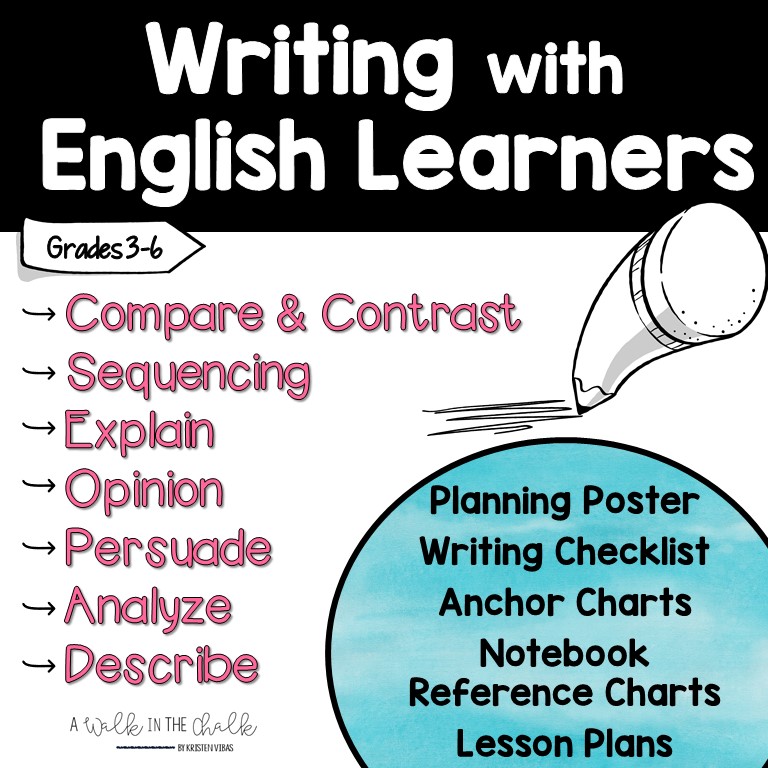Let's be real, planning weekly lessons in the ESL classroom can be an overwhelming task. Factors include caseloads and the sheer number of students/small groups serviced. Also, heterogenous groupings with a variety of language levels make it difficult to target specific language needs of students. Perhaps you're a new teacher and simply haven't had the guidance yet on planning ESL lessons. Here are a few tips to help make planning less stressful.
Let's start with a few pre-planning tips. These will support successful lesson planning.

PRE-PLANNING TIPS
1- Lesson Planner Book
It's really important to have a place to keep all things planning in one place. I don't know where I'd be without my lesson plan book.
Things I keep in my planner in addition to lesson plans are: 1- Student lists with ELP levels broken down by each domain, 2- The curriculum my students are learning in their gen ed classrooms so that I can integrate my ELD lessons with the grade level content whenever possible, 3- A calendar to keep me on track with events that impact my instructional schedule, such as meetings and testing, 4- Language goals and data collection to track student progress.
There are some really awesome print and go planners, as well as digital planners out there. Find one that suits your needs AND brings you joy. :)
2- Know Your Students
One of our main goals is to take students from their current language proficiency level to the next level. Knowing students and their needs is critical to planning appropriate lessons.
Students have an English Language Proficiency (ELP) level, but what does that mean exactly? So, my student has an ELP level 3, but what can she do in each language domain? I won't know what to teach her if I don't know the starting point for her.
Look at the breakdown of all 4 language domains and identify the weaker domains for each student. Keep this information in your plan book, or somewhere easily accessible. This is valuable information, but it's a very small piece of data. More importantly, I need to know what my students can do right now. Their latest scores might be 6 months old, so I want to also gather current data.
Assessments I give at the beginning to determine starting points:
phonemic awareness (newcomers)
phonics
writing (give a prompt that students have plenty of background knowledge)
reading
I need to know what level of reading I can expect from students, not just with decoding, but more importantly comprehending.
For writing, if my student is a newcomer with little to no English, I want to see a sample of their writing in their native language. This will give a lot of information about the literacy skills new students bring to the table.
Once I know what my students CAN DO, I can then plan targeted ELD lessons to meet their language and literacy needs. Without this information, I'd be trying to hit a target in the dark, and that's not servicing the students or myself.
3- Student Placement in Small Groups
Each small group, in my opinion, should be homogeneous. I group students according to needs, not necessarily by ELP level, although generally it works out that most level 3 students, for example, have similar needs, but not always. Grouping students with similar needs is key to targeting the skills they need to move from one level to the next.
OK, I've got my plan book, my student data and my small groups identified by need. Now what?
Tips to Make Lesson Planning Less Stressful
1- Consistent Weekly Activities
Incorporate consistent activities that target your students' needs, preferably that don't require planning time, and add them in your plan book every week. For example, I go through my plan book and add "phonics" to certain days for certain groups each week, so that's one less thing I need to plan. I have all the phonics materials on hand, so I simple print out and copy what I need and go.
I also do an Idiom of the Week activity and a "Friday Focus on Grammar" for other groups. Those automatically go into my lesson plan book each week as well!
Several of my groups have a warm-up activity when they first come into my room. The activity takes
about 5-10 minutes, but that's another chunk of time I don't need to plan. My level 1s and 2s have an irregular sight word booklet, and my level 3s and 4s have a Restate the Question writing prompt.
 |
| Irregular Sight Words - Warm Up Activity |
Finding consistent and meaningful weekly activities to add to your plan book cuts down on planning time.
Other examples of weekly activities:
-Grammar lessons (so many possibilities- What do YOUR students need?)
-Vocabulary - multiple meaning words, synonyms/antonyms, shades of meaning words, content
vocabulary, affixes, thematic monthly vocabulary, etc.
-Idiom of the Week
-Word Work - Affixes is a great focus area!
-Read Alouds
-Let's Talk! -oral language activities (purposeful oral language development is so important)
One of my favorite "Let's Talk!" activities is projecting a picture and having students talk about what they see happening. It could be content related or simply an interesting photograph. An awesome resource for this is Chuck Dillon's website. He's such a fantastic illustrator! Each picture has tons of action, which means there's never a shortage of things to talk about.
Pick a couple of "Weekly Activities" and plug them into your plan book each week.
Here's a blog post that shares "3 Weekly Activities that Do Not Require Planning."
2 - "Go-To" Activities
These are helpful to have on hand whenever you feel unsure about what to plan next, or you just need a meaningful "filler" lesson. We all need those from time to time. These lessons are still high-quality lessons that target the needs of our students, but they don't require planning time.
Some Go-To Activity Examples:
PWIM with any picture (picture word inductive model)
Inferring using pictures
5 Ws and H using pictures
Mind Maps
Language Games
This Build a Sentence activity uses the PWIM strategy to generate words about a picture. In this activity, we use the words to generate sentences of varying lengths. And on this particular day, I also challenged my students to use position words in their sentences.
To start, I ask students to tell me something they see in the picture. The students generate the words and I write them on the board in different colors depending on the part of speech. Students also generate the sentences, and I support with grammar, as needed.
It's a great activity to have on hand, as it covers many skills and is easily adaptable.
They are "one and done" lesson activities that are meaningful AND build language skills. Having a variety of these resources to pull from definitely makes planning less stressful because I know I have language building lessons that I can plug in whenever needed.
3- Language Function or Thematic Units
If you know me at all, you know I LOVE planning and teaching language function units. This truly makes my planning less overwhelming. MOST, if not all, of my students across multiple grade levels work on building language around the same language function, so when I plan, I have one LF in mind for everyone. Whoo-hoo!
For example, when I teach the language of Compare and Contrast, I focus on that language with all of my groups. I don't have 10 different groups doing 10 different things; they are ALL learning the language of Compare/Contrast, which makes planning SO much more manageable! Some groups might need more focus on expressive language skills while others need more practice with receptive language skills, but I know that the overarching focus for all is the language of Compare/Contrast.
Plus, often times I can reuse lessons with multiple groups. Halleluiah! And by tweaking lessons with some additional scaffolds, I can use them with even more groups. This is a huge time saver!
 |
| Language Function: Compare/Contrast |
 |
| Language Function: Fact/Opinion |
Each language function unit lasts about 4 weeks; and once it's planned out, there's not a lot of additional planning that needs to be done during that time period.
I don't start a new unit until all my groups are finished, so while I'm finishing up the unit with some groups, I use "filler" lessons with the groups that are already done.
To learn more about incorporating language function units in the ESL classroom, check out the blog post links below.
4- Reusing lessons is honestly my #1 tip for making planning more manageable and less stressful. And maybe you can't use an entire lesson with multiple groups, but you can use a portion of the lesson. How many groups can I use this lesson with? How can I tweak this lesson so that I can use it with more groups? Those are questions I ask myself as I plan.
RECAP:
1- Incorporate Consistent Weekly Activities (phonics, grammar, vocabulary) and plug them into your plan book each week.
2- Go-To Activities (have a variety of meaningful filler activities on hand)
3- Language Function Units (all groups learning the same Language Function)
4- Reuse Lessons with multiple groups!
As I mentioned earlier, sometimes the overwhelming feeling of planning comes from the sheer number of students and groups serviced. Or it could be that our numbers are low, but we service 6-12 grade levels. Many ESL teachers travel between schools. There's a variety of reasons that can make planning stressful. Regardless of the reasons, having these tools in your teacher toolbox can help make planning less stressful.
Linked below are some of the blog posts and instructional resources mentioned in this post.









.jpg)
.jpg)




























Thank you for sharing this. This is so helpful.
ReplyDeleteYou're welcome, Elizabeth:) I'm glad it's helpful.
ReplyDelete